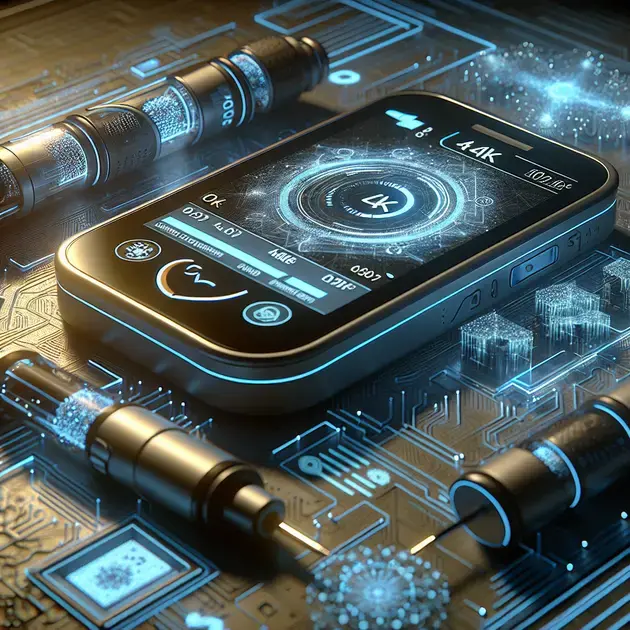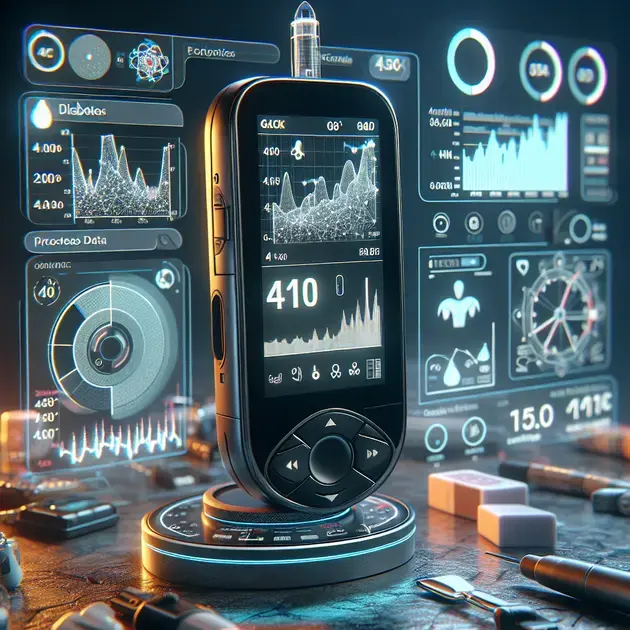How Does a Glucose Blood Sugar Monitor Work?
Discover the inner workings of a glucose blood sugar monitor and how it helps manage diabetes. From pricking the finger to reading blood glucose levels, this article delves into the technology behind these essential devices and how they provide accurate and timely information for monitoring blood sugar levels.

Understanding Glucose Blood Sugar Monitoring
Glucose blood sugar monitoring is a crucial aspect of managing diabetes. By regularly checking your blood sugar levels, you can track how your body responds to food, exercise, and medication, allowing you to make informed decisions about your health. To start monitoring your glucose levels, you can use a glucose meter, a small device that measures the concentration of glucose in your blood.
For accurate results, it’s important to follow the instructions provided with your glucose meter. Typically, the process involves pricking your finger to draw a small drop of blood, which is then placed on a test strip inserted into the meter. The meter then displays your blood sugar level within seconds. Many glucose meters also allow you to store and track your results over time, providing valuable insights into your health.
Several mobile apps, such as Glucose Buddy and mySugr, are available to help you manage your blood sugar levels more efficiently. These apps allow you to log your blood sugar readings, track your meals and physical activity, set reminders for medication, and even share your data with healthcare providers for better guidance and support.
Regular glucose blood sugar monitoring empowers individuals with diabetes to take control of their health and make proactive choices that can improve their overall well-being. By staying informed about their blood sugar levels, people can better manage their condition and enjoy a healthier life.
The Technology Behind Glucose Blood Sugar Monitors
Glucose blood sugar monitors utilize advanced technology to provide accurate and reliable results. Modern glucose meters are equipped with biosensors that use an enzyme called glucose oxidase to detect glucose levels in the blood sample. When the blood comes into contact with the test strip, the enzyme reacts with the glucose present, producing a chemical signal that is then converted into a digital readout by the meter.
Continuous glucose monitors (CGMs) take glucose monitoring to the next level by providing real-time readings throughout the day. CGMs consist of a sensor that is inserted under the skin to measure glucose levels in the interstitial fluid. The sensor communicates wirelessly with a receiver or smartphone, displaying trends and alerts for high or low glucose levels.
Bluetooth connectivity is a common feature in many modern glucose monitors, allowing seamless data transfer between the meter and your smartphone or computer. With Bluetooth-enabled meters, you can easily sync your readings to the accompanying app for comprehensive data analysis and tracking.
Some glucose monitors also offer cloud storage options, enabling users to securely backup their data and access it from multiple devices. This not only ensures data safety but also facilitates sharing important information with healthcare providers for better treatment and monitoring.
As technology continues to advance, glucose blood sugar monitors are becoming more user-friendly, accurate, and integrated into the digital health ecosystem. These innovations are transforming diabetes management and empowering individuals to lead healthier lives with greater convenience and insights.
Key Components of a Glucose Blood Sugar Monitor
A glucose blood sugar monitor consists of several essential components that work together to provide accurate readings and valuable data for diabetes management. The main components include the meter itself, test strips, lancets, control solution, and a lancing device.
The glucose meter is the handheld device used to analyze blood samples and display glucose readings. It is essential to choose a meter that meets your specific needs in terms of accuracy, speed, and data management capabilities.
Test strips are disposable strips coated with chemicals that react to glucose in the blood sample. The meter reads the chemical reaction on the strip and calculates the corresponding glucose level. It’s crucial to use compatible test strips designed for your meter to ensure accurate results.
Lancets are small needles used to prick the skin and obtain a blood sample for testing. They are typically loaded into a lancing device, which controls the depth of the needle and ensures a consistent and less painful sampling experience.
Control solution is a liquid with a known glucose concentration that is used to check the accuracy of the meter and test strips. By testing the control solution regularly, you can verify that your glucose monitor is providing reliable results and calibrate it if necessary.
Understanding the key components of a glucose blood sugar monitor is essential for effective monitoring and management of diabetes. By familiarizing yourself with how each part functions and ensuring proper usage, you can achieve accurate and consistent results, leading to better control of your blood sugar levels and overall health.

**Choosing the Right Glucose Blood Sugar Monitor**
When selecting a glucose blood sugar monitor, there are several key factors to consider to ensure it meets your needs effectively. Firstly, it’s essential to determine if you prefer a traditional blood glucose monitor that requires a finger prick for blood samples or a continuous glucose monitoring system that offers real-time readings throughout the day. Consider your lifestyle, budget, and comfort level with technology when making this decision.
Another important aspect to consider is the accuracy and reliability of the glucose blood sugar monitor. Look for a device that provides consistent and precise readings to help you manage your blood sugar levels effectively. Reading reviews and consulting with healthcare professionals can help you identify monitors known for their accuracy.
Furthermore, the ease of use and convenience of the monitor should also be taken into account. Opt for a device that is user-friendly, with clear instructions and a simple interface. Features like backlight displays, data storage capabilities, and connectivity to smartphone apps can enhance the overall user experience and make monitoring your blood sugar levels more convenient.
Lastly, consider the size and portability of the glucose blood sugar monitor. If you lead an active lifestyle or travel frequently, a compact and lightweight device may be more suitable for your needs. Ensure that the monitor’s design aligns with your lifestyle to make monitoring your blood sugar levels seamless and hassle-free.
**How Glucose Blood Sugar Monitors Impact Daily Health**
Glucose blood sugar monitors play a crucial role in managing diabetes and promoting overall health and well-being on a daily basis. By regularly monitoring blood sugar levels, individuals can make informed decisions about their diet, medication, and lifestyle choices to keep their blood sugar levels stable and within a healthy range.
Continuous monitoring with a glucose blood sugar monitor allows individuals to track patterns and trends in their blood sugar levels throughout the day. By analyzing this data, users can identify factors that influence their blood sugar levels, such as food, exercise, stress, and medication, and make necessary adjustments to optimize their health.
Monitoring blood sugar levels also helps individuals and healthcare providers assess the effectiveness of diabetes management strategies and treatment plans. By closely monitoring blood sugar levels and making adjustments as needed, individuals can reduce the risk of complications associated with uncontrolled diabetes, such as heart disease, nerve damage, and kidney problems.
Additionally, regular monitoring with a glucose blood sugar monitor empowers individuals to take control of their health and make proactive choices to prevent or delay the onset of diabetes-related complications. By staying informed about their blood sugar levels and making lifestyle changes as necessary, individuals can improve their quality of life and reduce the impact of diabetes on their overall health.
**Future Innovations in Glucose Blood Sugar Monitoring**
The future of glucose blood sugar monitoring holds promising advancements that have the potential to revolutionize diabetes management and improve the quality of life for individuals with diabetes. One of the most anticipated innovations is the development of non-invasive or minimally invasive glucose monitoring technologies that eliminate the need for frequent finger pricks and blood samples.
Continuous glucose monitoring systems are also expected to become more advanced, with improved accuracy, longer wear times, and additional features that provide valuable insights into blood sugar control and trends. These advancements will enable individuals to monitor their blood sugar levels more effectively and make timely decisions to maintain optimal health.
Integration with digital health platforms and wearable devices is another exciting development in the field of glucose blood sugar monitoring. By connecting glucose monitors to smartphone apps, smartwatches, and other wearable technologies, individuals can access real-time data, set alerts and reminders, and share information with healthcare providers for personalized care and support.
Furthermore, the future of glucose blood sugar monitoring may also include artificial intelligence and machine learning algorithms that analyze data from glucose monitors to predict blood sugar trends and provide personalized recommendations for managing diabetes. These intelligent systems have the potential to empower individuals with diabetes to make informed decisions about their health and improve their long-term outcomes.
Conclusion
In conclusion, understanding glucose blood sugar monitoring is paramount for effectively managing diabetes and promoting overall health. By utilizing advanced technology such as glucose meters and continuous glucose monitoring systems, individuals can track their blood sugar levels, identify patterns, and make informed decisions to optimize their health. Furthermore, the key components of a glucose blood sugar monitor, such as the meter, test strips, and lancets, play a vital role in ensuring accurate and reliable results for diabetes management.
Regular monitoring with a glucose blood sugar monitor empowers individuals to take control of their health, make proactive choices, and prevent complications associated with uncontrolled diabetes. By staying informed about their blood sugar levels and making necessary lifestyle adjustments, individuals can improve their quality of life and reduce the impact of diabetes on their overall well-being.
Looking towards the future, innovations in glucose blood sugar monitoring, such as non-invasive technologies, enhanced continuous glucose monitoring systems, integration with digital health platforms, and artificial intelligence applications, hold great promise for revolutionizing diabetes management. These advancements aim to provide individuals with diabetes more convenient, accurate, and personalized monitoring solutions to improve their long-term outcomes and quality of life.
As technology continues to evolve and integrate into the realm of healthcare, glucose blood sugar monitoring stands at the forefront of innovation, transforming the way individuals manage their diabetes and inspiring a proactive approach to health and well-being. By staying informed, utilizing cutting-edge monitoring tools, and collaborating with healthcare providers, individuals can navigate their diabetes journey with confidence and empower themselves to lead healthier lives.